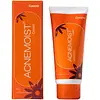What's inside
What's inside
 Key Ingredients
Key Ingredients

 Benefits
Benefits

 Concerns
Concerns

 Ingredients Side-by-side
Ingredients Side-by-side

Water
Skin ConditioningEthylhexyl Methoxycinnamate
UV AbsorberMethylene Bis-Benzotriazolyl Tetramethylbutylphenol
UV FilterIsononyl Isononanoate
EmollientJojoba Oil PEG-8 Esters
Skin ConditioningCyclopentasiloxane
EmollientHydroxyethyl Urea
HumectantSteareth-2
EmulsifyingSaccharide Isomerate
HumectantLaureth-23
CleansingBiosaccharide Gum-1
HumectantPEG-20
HumectantPhenoxyethanol
PreservativeEthylhexylglycerin
Skin ConditioningAcrylates/C10-30 Alkyl Acrylate Crosspolymer
Emulsion StabilisingTriethanolamine
BufferingDimethicone Crosspolymer
Emulsion StabilisingDisodium EDTA
Sodium Lauryl Sulfate
CleansingParfum
MaskingWater, Ethylhexyl Methoxycinnamate, Methylene Bis-Benzotriazolyl Tetramethylbutylphenol, Isononyl Isononanoate, Jojoba Oil PEG-8 Esters, Cyclopentasiloxane, Hydroxyethyl Urea, Steareth-2, Saccharide Isomerate, Laureth-23, Biosaccharide Gum-1, PEG-20, Phenoxyethanol, Ethylhexylglycerin, Acrylates/C10-30 Alkyl Acrylate Crosspolymer, Triethanolamine, Dimethicone Crosspolymer, Disodium EDTA, Sodium Lauryl Sulfate, Parfum
Water
Skin ConditioningNiacinamide
SmoothingButylene Glycol
HumectantEnantia Chlorantha Bark Extract
Skin ConditioningOleanolic Acid
Skin ConditioningEthylhexyl Palmitate
EmollientSorbitan Oleate
EmulsifyingSorbitan Laurate
EmulsifyingMyristyl Malate Phosphonic Acid
Skin ConditioningGlycerin
HumectantIsononyl Isononanoate
EmollientHydroxyethyl Acrylate/Methoxyethyl Acrylate Copolymer
Cetearyl Alcohol
EmollientCoco-Glucoside
CleansingPEG-100 Stearate
Glyceryl Stearate
EmollientCetyl Palmitate
EmollientPhenoxyethanol
PreservativeEthylhexylglycerin
Skin ConditioningZinc PCA
HumectantPolyacrylate Crosspolymer-6
Emulsion StabilisingMagnesium Aspartate
Skin ConditioningZinc Gluconate
Skin ConditioningCopper Gluconate
Skin ConditioningSodium Acrylate/Sodium Acryloyldimethyl Taurate Copolymer
Emulsion StabilisingCaesalpinia Spinosa Gum
Skin ConditioningDisodium EDTA
Triethanolamine
BufferingWater, Niacinamide, Butylene Glycol, Enantia Chlorantha Bark Extract, Oleanolic Acid, Ethylhexyl Palmitate, Sorbitan Oleate, Sorbitan Laurate, Myristyl Malate Phosphonic Acid, Glycerin, Isononyl Isononanoate, Hydroxyethyl Acrylate/Methoxyethyl Acrylate Copolymer, Cetearyl Alcohol, Coco-Glucoside, PEG-100 Stearate, Glyceryl Stearate, Cetyl Palmitate, Phenoxyethanol, Ethylhexylglycerin, Zinc PCA, Polyacrylate Crosspolymer-6, Magnesium Aspartate, Zinc Gluconate, Copper Gluconate, Sodium Acrylate/Sodium Acryloyldimethyl Taurate Copolymer, Caesalpinia Spinosa Gum, Disodium EDTA, Triethanolamine
 Reviews
Reviews

Ingredients Explained
These ingredients are found in both products.
Ingredients higher up in an ingredient list are typically present in a larger amount.
Disodium EDTA plays a role in making products more stable by aiding other preservatives.
It is a chelating agent, meaning it neutralizes metal ions that may be found in a product.
Disodium EDTA is a salt of edetic acid and is found to be safe in cosmetic ingredients.
Learn more about Disodium EDTAEthylhexylglycerin (we can't pronounce this either) is commonly used as a preservative and skin softener. It is derived from glyceryl.
You might see Ethylhexylglycerin often paired with other preservatives such as phenoxyethanol. Ethylhexylglycerin has been found to increase the effectiveness of these other preservatives.
Isononyl Isononanoate is a synthetic skin-conditioner and texture enhancer. It is created from nonanoic acid, a fatty acid found in cocoa and lavender oil.
As an emollient, Isononyl Isononanoate helps keep your skin soft and smooth. This is because emollients create a barrier on the skin to trap moisture in.
Isononyl Isononanoate helps give products a velvet feel and improves spreadability.
Learn more about Isononyl IsononanoatePhenoxyethanol is a preservative that has germicide, antimicrobial, and aromatic properties. Studies show that phenoxyethanol can prevent microbial growth. By itself, it has a scent that is similar to that of a rose.
It's often used in formulations along with Caprylyl Glycol to preserve the shelf life of products.
Triethanolamine is an emulsifier and pH adjuster. It is created using ethylene oxide and ammonia. This gives Triethanolamine a nitrogen core and a similar scent to ammonia.
As an emulsifier, it prevents ingredients from separating and enhances texture by adding volume to a product.
PH adjusters are common in cosmetic products. The pH of a product can affect the effectiveness of other ingredients. A product with a high pH may also irritate the skin.
Learn more about TriethanolamineWater. It's the most common cosmetic ingredient of all. You'll usually see it at the top of ingredient lists, meaning that it makes up the largest part of the product.
So why is it so popular? Water most often acts as a solvent - this means that it helps dissolve other ingredients into the formulation.
You'll also recognize water as that liquid we all need to stay alive. If you see this, drink a glass of water. Stay hydrated!
Learn more about Water